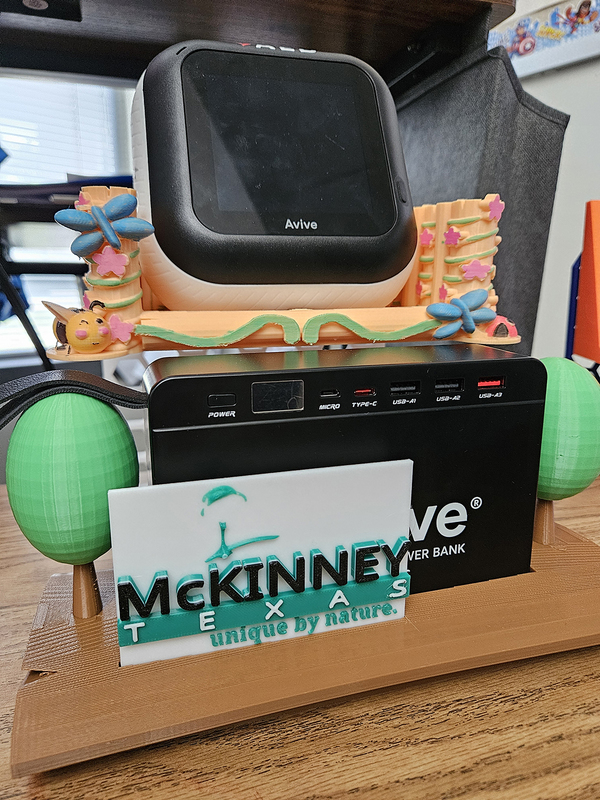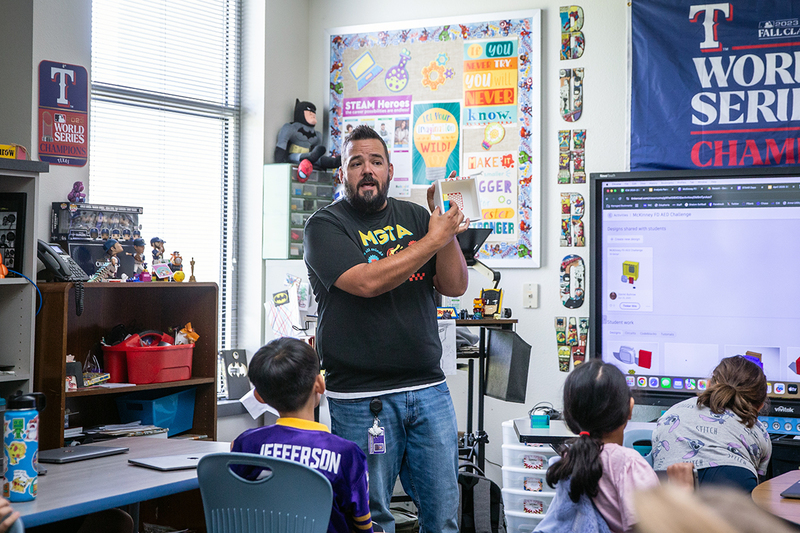McKinney ISD Students Use 3D printing to Support AED Access
In McKinney, lifesaving is more than a skill—it is a shared commitment. During CPR and AED Awareness Week (June 1–7), we are celebrating the collaborative efforts of the McKinney Fire Department, McKinney Independent School District (McKinney ISD), and local organizations working together to strengthen emergency response and improve survival outcomes from cardiac arrest.
Through shared vision and innovation, McKinney is demonstrating what is possible when communities align around a common goal: preparing more individuals to respond to cardiac emergencies and ensuring lifesaving tools such as automated external defibrillators (AEDs) are accessible throughout the city.

A student in Rico Sneller's class at Walker Elementary holds a demonstration AED device as she considers design options for the AED mount design project.
This work reflects the goals of the American Heart Association’s Nation of Lifesavers™ initiative—a national movement to double survival rates from cardiac arrest by 2030. The initiative encourages widespread CPR education, AED awareness, and the development of systems that support rapid response. McKinney’s approach exemplifies how local leadership, and collaboration can bring this vision to life.
Cardiac arrest can occur without warning, and immediate action is critical. Hands-Only CPR helps maintain blood flow to vital organs, while an AED can restore a normal heart rhythm. When used together, CPR and AEDs can double or even triple the chance of survival. Despite this, most cardiac arrests occur at home, and fewer than half of victims receive bystander CPR. Increasing community readiness is essential.

Students had the opportunity to display their AED mount designs for members of the McKinney Fire Department to consider.
The McKinney Fire Department has deployed more than 150 AEDs across the community, including in public libraries, parks, recreation centers, and police vehicles. This effort supports McKinney’s aim to become a designated “Lighthouse Community”—a distinction given to cities where every resident is within four minutes of an AED. Fewer than a dozen such communities exist nationwide, including nearby Carrollton, Texas, which became one of the first in the country to achieve this status led by Carrolton Fire Rescue.
A recent collaboration with McKinney ISD is helping to advance this goal by engaging students in real-world problem-solving. Led by the district’s GT STEM Lead Daniel Buhrow, fourth and fifth-grade students participated in a project that combined science, engineering, and civic responsibility. After learning about the circulatory system, cardiac arrest, and the role of CPR and AEDs in survival, students were introduced to a design challenge: how to mount the city’s new, smaller AEDs in public cabinets.

Walker Elementary teacher Daniel Buhrow discusses design issues and parameters for his students to consider as they begin their design work.
Traditional AED cabinets were built for older, bulkier models. The newer devices—while more portable—often do not fit securely and may appear unprofessional or difficult to access. The McKinney Fire Department identified this issue and tasked students with designing a custom container that would hold the AED securely and visibly inside the cabinet. Students received specifications, scale models, and access to a 3D scanner to measure the AED and its external battery.
Student teams tested their models under stress, calculated 3D printing costs, and presented their designs to McKinney Fire Department personnel—responding to questions about durability, efficiency, and design uniqueness. Inspired by McKinney’s “Tiny Doors” public art project, students were encouraged to incorporate creativity into their solutions. One student’s design mimicked a video game console and controller—an imaginative concept that would be especially fun and fitting for placement in an arcade or entertainment venue.

Students had the opportunity to display their AED mount designs for members of the McKinney Fire Department to consider.
Several of the student-designed models are now being evaluated for real-world use, with the potential to be installed in AED cabinets across McKinney. By creating a custom solution in-house, the McKinney Fire Department estimates the city could save hundreds of dollars per unit compared to purchasing commercial alternatives—funds that can instead be used to place more AEDs in the community. The project not only solved a practical challenge but also demonstrated how local innovation can stretch lifesaving resources further.
“I am so humbled and in awe at the work they are doing! We really have a great community,” said Battalion Chief Ben Jones of the McKinney Fire Department. “These students are helping solve real problems—and they are doing it with creativity, heart, and purpose. People my age often walk past an AED without noticing it or thinking about it. Now, elementary school students are coming up and telling me where they have seen AEDs in the community. That kind of awareness is powerful—and it is exactly what this initiative is about.”
Educators also noted the impact. One teacher shared that students began noticing AEDs in grocery stores, gyms, and parks—places they had never paid attention to before. “They’re not just learning science—they’re learning how to save lives,” the McKinney ISD teacher said.

